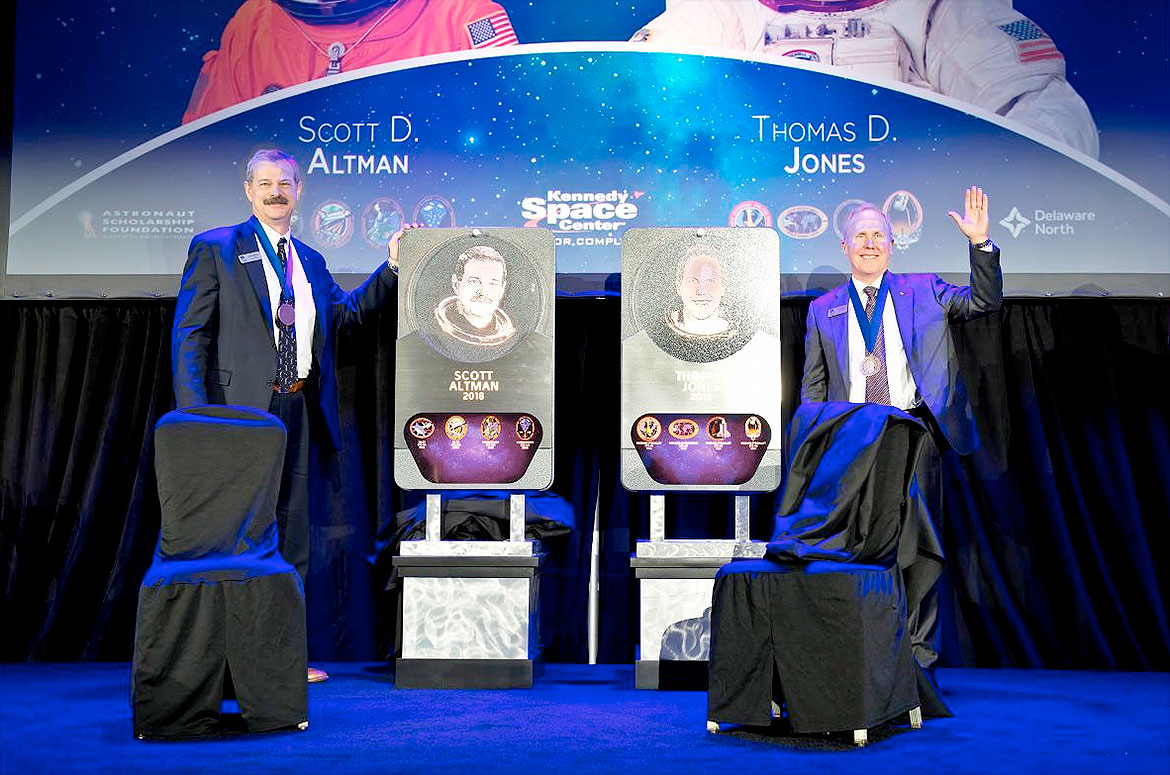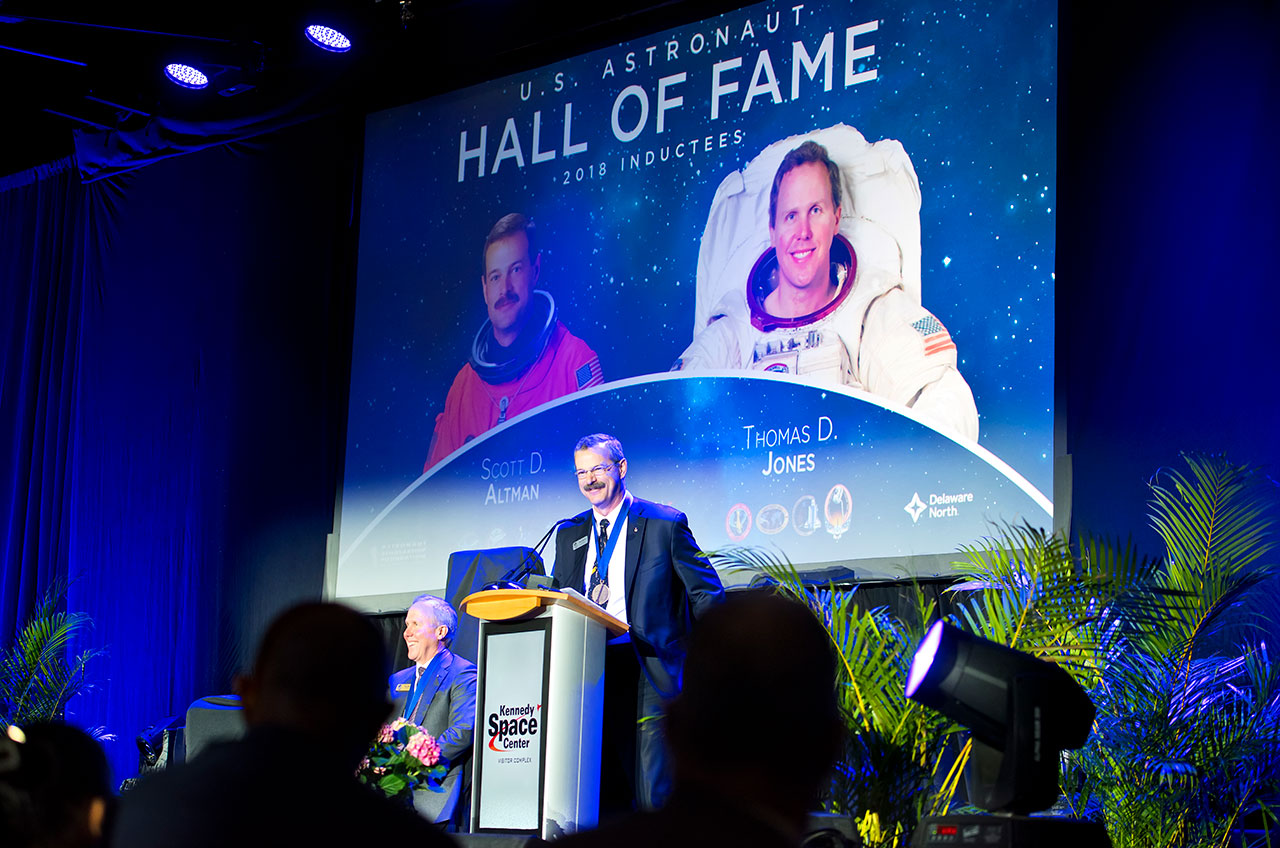Astronaut Hall of Fame Adds Space Shuttle Commander and Spacewalker

Scott Altman and Thomas Jones are no strangers to seeing their names included among the stars.
The two NASA veterans became the 96th and 97th space explorers to enter the U.S. Astronaut Hall of Fame during a public induction ceremony on Saturday (April 21) under the space shuttle Atlantis at the Kennedy Space Center Visitor Complex in Florida. More than 15 of their fellow astronauts joined NASA and center officials in& welcoming Altman and Jones into the Hall.
"Today we're here to honor two space explorers who have flown a combination of eight space missions, one as a pilot and commander, one as a scientist and spacewalker," said John Zarella, a space news correspondent and the emcee for the ceremony. "One is named in movie credits, one has an asteroid name for him." ['Heroes & Legends' Astronaut Attraction to Include Videos Shared by Public]
Before becoming an astronaut, Navy Capt. Scott "Scooter" Altman stood in for Tom Cruise in the 1986 film "Top Gun," flying the F-14 jet aerobatic flight sequences.
Jones also served as a military pilot, flying bombers for the U.S. Air Force, before becoming a planetary scientist and a management engineer in the CIA's office of development and engineering. The main belt asteroid 1082 TomJones is named in his honor.
But soaring among Hollywood stars and space rocks pales in comparison to their latest honor, they both said.
"I will take both honors, but this is definitely a higher one," Jones told collectSPACE shortly after he was inducted into the Hall. "To be part of this group, my heroes growing up, it is really indescribably gratifying and rewarding."
Breaking space news, the latest updates on rocket launches, skywatching events and more!
"The movie was fun, but it is not an honor like this at all," said Altman. "This is on a whole different plane."
Jones and Altman were nominated for induction by a panel of prior astronaut inductees, retired NASA flight controllers and managers, journalists and historians organized by the Astronaut Scholarship Foundation. The honor pays tribute to the achievements they made in space and the work they have done since departing the astronaut corps to continue to advance space exploration.
Selected with NASA's 13th and 15th classes of astronauts in 1990 and 1995, respectively, Jones and Altman flew on four space shuttle missions each. Altman logged 51 days and 12 hours in Earth orbit, while Jones spent a day and a half more, circling the planet for 53 days.
As a space shuttle pilot and then commander, Altman flew missions aboard orbiters Columbia and Atlantis.
Altman made his first spaceflight as the pilot of STS-90 in 1998, a mission dubbed "Neurolab" due to its focus on the effects of microgravity on the function of the human brain and nervous system. Two years later, he piloted STS-106, which was dedicated to preparing the International Space Station for the arrival of its first resident crew.
Altman's third and fourth flights were as the commander of the final two missions tasked with repairing and upgrading the Hubble Space Telescope. On STS-109 in 2002 and on STS-125 in 2009, Altman flew the shuttle to a rendezvous with the orbiting observatory, where his crew spacewalked to service the Hubble.
"I am proudest of the two Hubble missions I commanded," Altman told collectSPACE. "The adversity we overcame, especially on the final mission where every day I thought I was going to be the commander of the crew that killed the Hubble. And somehow we worked through it and ended up getting every single task that was possible for us to do on that mission performed, putting Hubble at the peak of its capability for its entire life when we deployed at the end of the mission."
Following his return to Earth, Altman served as the chief of the exploration branch of NASA's Astronaut Office during the selection of the Orion spacecraft as the agency's next generation crew vehicle. He left NASA in 2010 and is now the senior vice president for civil programs for all of ASRC Federal's NASA and NOAA programs, including assembly of Orion capsules for upcoming exploration missions.
Jones' four shuttle flights were as a mission specialist on board Atlantis, Columbia and Endeavour.
Jones' first two launches were separated by less than six months. On STS-59 and STS-68 in April and September of 1994, Jones and his crewmates operated the Space Radar Laboratory, studying Earth's environment.
Jones' third space mission, STS-80, was the longest in the shuttle program's 30-year history. During the 17 days and 16 hours that he was in orbit, Jones helped to deploy and recover science satellites, but his two planned spacewalks were canceled due to a jammed airlock hatch.
Jones ultimately succeeded in walking in space on a trio of extravehicular activities (EVAs) during the STS-98 mission in 2001. He helped to install the U.S. Destiny laboratory on the International Space Station, including his overcoming a critical ammonia leak. In total, Jones logged 19 hours and 48 minutes working in the vacuum of space.
"I have done things that other people have done, so I don't think there is any one thing that I can point to that says, 'Tom Jones was a groundbreaker' in this or that direction," he said. "But I think what I was able to do consistently was to be a good team member for my crewmates and I tried to work well with people across programs."
Since departing NASA in 2001, Jones has authored more than 200 technical and popular articles, as well as penned five books about space and aviation. Jones is now a senior research scientist with the Florida Institute for Human and Machine Cognition and the chairman of the Association of Space Explorers' near-Earth object committee, supporting international efforts to detect and deflect rogue asteroids.
Both Jones and Altman said that they hope their presence in the U.S. Astronaut Hall of Fame can help inspire a new generation of space explorers.
"I hope that they can take a connection away from it that 'hey, here is somebody who came from a relatively humble background who somehow persevered. If he can do those things, then I can do it,'" said Altman.
"Building the space station, for me, was a chance to prove what we could do and have for the last 17 years — people living off Earth," said Jones. "I hope that young kids will go away from this thinking, 'you know, I too can be part of this future because there are people up there right now. If they can be up there, then I have a chance to do that and make new discoveries.'"
The U.S. Astronaut Hall of Fame was founded in 1990 at the suggestion of the original Mercury astronauts. It is now a featured part of Heroes & Legends, a public attraction at the Kennedy Space Center Visitor Complex.
Watch highlight video clips from the 2018 U.S. Astronaut Hall of Fame induction ceremony at collectSPACE.
Follow collectSPACE.com on Facebook and on Twitter at @collectSPACE. Copyright 2018 collectSPACE.com. All rights reserved.

Robert Pearlman is a space historian, journalist and the founder and editor of collectSPACE.com, a daily news publication and community devoted to space history with a particular focus on how and where space exploration intersects with pop culture. Pearlman is also a contributing writer for Space.com and co-author of "Space Stations: The Art, Science, and Reality of Working in Space” published by Smithsonian Books in 2018.
In 2009, he was inducted into the U.S. Space Camp Hall of Fame in Huntsville, Alabama. In 2021, he was honored by the American Astronautical Society with the Ordway Award for Sustained Excellence in Spaceflight History. In 2023, the National Space Club Florida Committee recognized Pearlman with the Kolcum News and Communications Award for excellence in telling the space story along the Space Coast and throughout the world.



